Getting a taste of Japanese comfort food
COOKBOOK REVIEW
By Debra Samuels
GLOBE CORRESPONDENT DECEMBER 31, 2013
Tadashi Ono and Harris Salat take on home cooking in “Japanese Soul Cooking: Ramen, Tonkatsu, Tempura, and More From the Streets and Kitchens of Tokyo and Beyond”
Ten Speed Press Number of pages:256 pp. Book price:$27.50
Harris Salat, owner of Ganso, a Japanese comfort food restaurant in Brooklyn, and celebrated chef Tadashi Ono, who recently opened Maison O in New York, have teamed up for the third time in “Japanese Soul Cooking.” The pair look at homestyle food, street fare, and izakaya (pub) food. Much of this fare was influenced by non-Japanese dishes that, once adapted to local tastes, became so familiar in Japan that residents think of them as their own.
The most famous is ramen, originally from China, and then there’s curry (from India via England), and tempura (from Portugal). The authors frame each import with historical tidbits about its arrival — often through foreign chefs cooking at hotels — and its subsequent migration into homes, schools, and restaurants.
Matte-finished pages are filled with appealing photographs of everyday meals in Japan, big bowls of noodles, homey rice bowls, children eating, and all manner of street and festival cuisine, in muted hues that exude warmth and generate intense nostalgia for those of us who know Japan and its cooking. (Four decades ago, encouraged by helpful neighbors, I learned to cook Japanese soul food on a two-burner stovetop in an urban Tokyo apartment, which began a lifelong interest in the cuisine and the country.)
One beloved dish in a chapter on Western-derived pancakes is okonomiyaki, a savory pancake stuffed with shredded cabbage and topped with a thick Worcestershire-like sauce, the Japanese mayonnaise Kewpie, smoky fish flakes (called katsuobushi), and seaweed sprinkles (aonori), an odd quartet of salty, creamy, fishy, and piquant that is pure harmony.
The street snack takoyaki are round octopus fritters. The recipe calls for adding grated gluey mountain potato, called yama imo, to a pancake batter (this isn’t unusual), studded with cooked octopus and topped with the same savory quartet as the pancake. Instructions are spot on, resulting in fluffy orbs.
Another chapter is devoted to wafu (Japanese-style) pasta. Here, you’ll find dishes like spaghetti tossed with mentaiko, spicy pollock roe from Korea, and cream sprinkled with threads of roasted seaweed. A “Napolitan” spaghetti, now a school lunch staple, combines smoked sausages, ketchup, Parmesan, and Tabasco. That, write the authors, is a postwar creation by a Japanese chef using leftover spaghetti and ketchup courtesy of American GIs.
Three chapters are devoted to diverse methods of deep-frying: furai (panko-coated), kara-age (coated with potato starch), and tempura (flour-based batter). The authors insist that during frying you keep the oil at 340 degrees. I made tatsuta-age, which is ginger-garlic fried chicken thighs, and guessed at the temperature, paying dearly with an oily product. But when I used a thermometer as instructed for nagoya tebasaki (spicy chicken wings), my husband proclaimed them “hyaku-ten” (a perfect rating of 100 points). I went back and did the tatsuta-age again, this time with the thermometer and got great results.
Russian-inspired potato salada, a bento-box staple, made with lightly smashed potatoes, salted vegetables, and Kewpie mayonnaise, is the best version I have tasted. Kewpie mayo is key and it does contain MSG, which the authors acknowledge. Flavorful classic pork chahan (fried rice), a great leftovers dish often made by dads on weekends, features day-old rice stir-fried in sesame oil, Chinese-style, with both oyster and soy sauces.
Some recipe instructions are impractical or explanations are incomplete. The authors say to “serve piping hot” a dish of tatsuta-age, ginger chicken fried in batches. This would require the cook to stand at the stove and scoop hot pieces onto plates. After the third batch, the first is no longer hot. But more to the point: Ginger chicken is often served at home or sent to school in lunchboxes and it doesn’t suffer. And surprisingly, there is no recipe for short-grain Japanese rice, which is called for in many recipes.
If the authors are correct — that Americans no longer think of Japanese food as all sushi and they’re willing to delve into the world of comfort food — families here will be ready to sit down at a typical Japanese mom’s table. When the food comes, you say “itadakimasu,” an expression of gratitude. And you will be grateful.
RECIPE
Serves 4
This is an example of donburi, hearty rice bowls with various toppings of tempura, pork cutlets, tuna sashimi, or chicken, eaten in restaurants devoted to the genre and also made at home. “Oyako means parent and child, a nod to the two main ingredients, chicken and egg,” write “Japanese Soul Cooking” authors Harris Salat and Tadashi Ono. Oyakodon is made with chunks of chicken thighs and thinly sliced onions simmered in a soup made of dashi (smoky fish stock), mirin, sake, and soy sauce, and finished with a flourish of velvety eggs. Traditionally dashi is made from scratch with smoked fish flakes and kombu steeped in boiling water. You can find dashi packs or powder in Asian markets specializing in Japanese cuisine. Chicken stock or granules is not a good substitute, but you can use water. Note that you need cooked short-grain white rice to make the dish (easiest done in a rice cooker, if you have one, according to manufacturer’s instructions).
| 2 | large onions, halved and thinly sliced |
| 1 | pound skinless, boneless chicken thighs, cut into 1½-inch pieces |
| ½ | cup mirin |
| ½ | cup soy sauce |
| ½ | cup dashi or water |
| ½ | cup sake |
| 8 | eggs, lightly beaten |
| 2 | cups short-grain white rice, cooked (to make 6 cups) |
| 2 | scallions, thinly sliced |
| 2 | sheets nori (roasted seaweed), crumbled |
| Shichimi togarashi (Japanese 7-spice powder), (for sprinkling) |
1. In a large, deep skillet over high heat, combine the onions, chicken, mirin, soy sauce, dashi or water, and sake. Bring to a boil, lower the heat, and simmer for 5 minutes until the chicken is cooked through.
2. Pour ¾ of the eggs over the entire surface of the chicken mixture. Without stirring, cook for 1 minute, or until the eggs begin to set. Pour the remaining eggs over the mixture. Do not stir. Cover and cook for 30 seconds more. Turn off the heat and let rest for 1 minute.
3. Divide the rice among 4 large bowls. With a ladle, scoop chicken mixture onto the rice. Sprinkle with scallions and garnish with seaweed and shichimi togarashi, if using.
Adapted from “Japanese Soul Cooking”

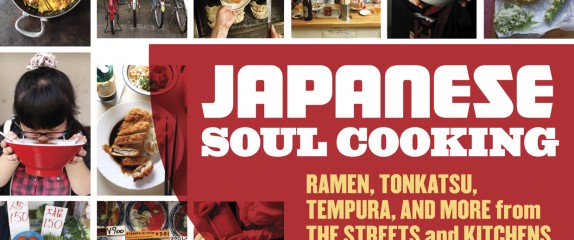
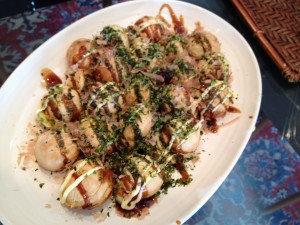
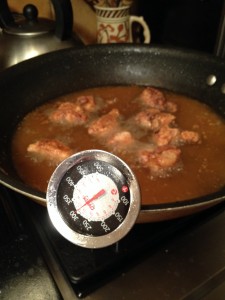
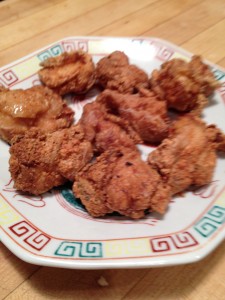
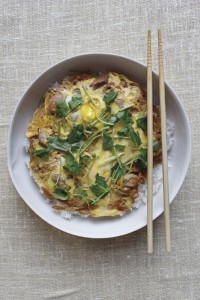










 Debra Samuels, bestselling author, food writer and cooking instructor,
Debra Samuels, bestselling author, food writer and cooking instructor,